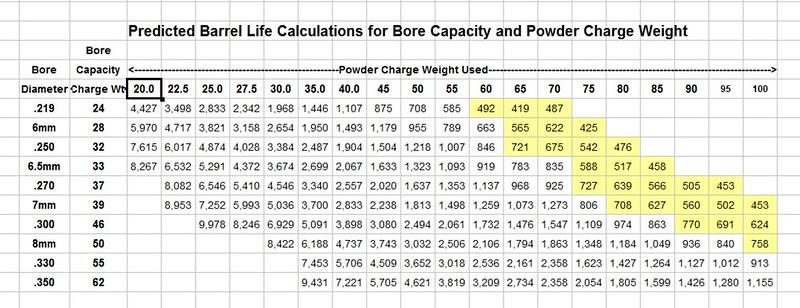I researched barrel life top ranked competitive shooters and Sierra Bullets testing bullets for accuracy got from several cartridges loaded to SAAMI spec max average pressure. Barrel life standard was when the average 100-yard test group was about 1/4 MOA then opened up to about 3/8 MOA. That's when these folks decided the barrel was worn out for their objectives.How is bore capacity calculated?
Bore capacity had all sorts of definitions. I wanted one that was fixed for a given bore diameter; not groove diameter. That would keep overbore and underbore capacity relative to some standard. In comparing barrel lives across several cartridges, one thing stood out above all others. Bores with a cross sectional area in square millimeters had a barrel life of 3000 rounds when the powder charge weight in grains was the same number as square millimeters. 46 was the grains of powder in .308 Win cartridges that gave 3000 rounds of barrel life with the bore cross sectional area of 46 square millimeters. Other calibers fared much the same. Open the following image in a separate window.

Cartridges with about 40% more powder for a given bore had about 1/2 or 1500 rounds for the barrel life. Twice as much powder produce about 1/4 the barrel life; 750 rounds. Yellow shaded areas are questionable; there is evidence that the bore erosion rate is much faster in this area which reduces barrel life a lot more such as the 7mm STW.
These numbers were based on average powder burning temperatures. Forum member mikecr used Quickload's powder heat indexes for his formula so that characteristic would be figured in. He also used a greater number for the barrel life standard in stead of my 3000 rounds. He may have used a different accuracy degradation figure instead of 50%.
Hunting rifles may well have twice the barrel life number; 6000 or so and have bigger starting out groups. It depends on lots of things. But for service rifles like the M1, M14 and M16, their barrel life standards are about 10,000 rounds before accuracy had degraded too much for combat use with much larger groups to start out with.
This is an approximation and guideline. Individual tests may yield different results.
Bore cross sectional area in square millimeters:
* bore diameter in inches squared times .7854 times 645.
* bore diameter in millimeters squared times .7854.

